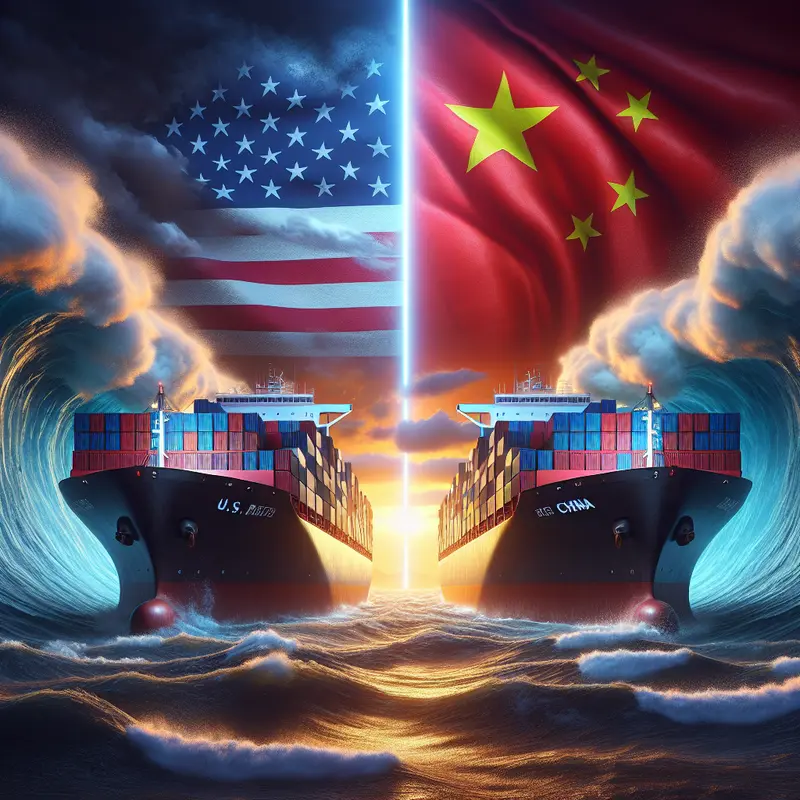The ongoing trade conflict between the U.S. and China has escalated to unprecedented levels, with tariffs exceeding 100% on Chinese goods. This friction threatens the global economic stability and signals a shift in trade dynamics. In this analysis, we explore the multifaceted repercussions of this trade war, examining China’s economic strategies, the challenges posed by U.S. national debt and interest rate fluctuations, and the overall global implications of these tensions for investors and markets. Each chapter will provide insightful perspectives to understand the full impact of this ongoing economic saga.
Economic Fallout and Strategic Tensions in the US-China Trade War

The intensifying trade conflict between the United States and China, characterized by tariffs exceeding 100%, is reshaping economic landscapes and heightening global tensions. While tariffs have long been a tool for economic diplomacy, their magnified use in this conflict underscores a dramatic shift from economic interdependence to a stark confrontation with potential long-lasting repercussions on international trade.
At the core of this escalation is the attempt to redress perceived imbalances. The U.S. tariffs, encompassing over 100% on certain Chinese goods, are part of a strategy to curb the trade deficit and incentivize domestic production. However, such high tariffs do more than merely raise import costs; they significantly suppress trade volumes. Bloomberg Economics has projected that the imposition of these tariffs could nearly obliterate U.S. imports from China over time, thereby triggering a recalibration of global supply chains reverberating through international markets.
The specter of economic decoupling looms large over this conflict. Janet Yellen, a former Treasury Secretary, warns that the splintering of these entwined economies could wield disastrous outcomes. The dismantling of intricate supply chains not only disrupts manufacturing but also risks substantial job losses, presenting a grim economic landscape. The U.S. is already contending with an elevated average tariff rate of 24.7% on all imports, which could severely impact its GDP, potentially resulting in a reduction of up to 3.6%. Concurrently, this situation imposes inflationary pressures that can undermine consumer purchasing power, thereby straining the economy further.
The manufacturing and agricultural sectors are particularly exposed to the caprices of these amplified tariffs. The strategic aim of fostering U.S. manufacturing through import substitution is hindered by its reliance on Chinese intermediates and machinery, thus complicating production processes and employment stability. Similarly, the agricultural sector—which looks to China as a significant market for exports—faces declining revenue and mounting uncertainties as tariffs elevate the cost of American goods overseas.
Crucially, the conflict serves as a battleground for strategic resources. China wields influence over the global supply of rare earth minerals, critical to U.S. tech and defense industries. By tightening exports of these strategic materials, China can disrupt American technological and defense operations, heightening its bargaining power in trade negotiations and policy discussions. Yet, the U.S. counters this leverage through its dominance in semiconductors and advanced manufacturing, highlighting an intricate balance of power where each side holds valuable cards.
Negotiations sit at an impasse, with both countries entangled in a profound strategic game. The U.S. holds the advantage in sheer import volumes, while China leverages its control over strategic commodities, thereby sustaining a cycle of retaliations and hardened policy stances. President Trump’s threats to abandon negotiations reflect the uncompromising nature of this conflict, which Beijing has matched with its resolve to endure protracted economic strife.
The tumultuous trade landscape precipitates a wave of global market volatility. Trillions of dollars have vanished from the global equity markets, an alarming ripple effect of this economic confrontation. As the S&P 500 Index fluctuates, investor sentiment wavers, and the foundation of global economic stability is threatened. The resulting disarray underscores a broader crisis of confidence that could lead to a fragmented global trade system, where bilateral agreements replace erstwhile multilateral frameworks, diminishing the cohesive functionality of global commerce.
In this increasingly polarized world, the rise of such economic nationalism threatens to unravel decades of interconnected growth, presenting a formidable challenge to those reliant on the stability and predictiveness of the global trade apparatus. This ongoing conflict, marked by ever-rising tariffs, not only reshapes the economic pursuits of two of the world’s largest economies but also reverberates across the globe, heralding a potential inflection point in the geopolitics of trade.
Strategies Amidst Turmoil: China’s Economic Maneuvers in the Trade War

China’s response to the mounting trade war with the United States has necessitated a repertoire of strategic economic maneuvers designed to buffer its economy from the impact of punitive U.S. tariffs. As these tariffs have climbed to unprecedented levels, China’s efforts are rooted in both retaliatory actions and calculated economic policies aimed at sustaining growth and fortifying its global trade connections.
The most immediate response from China has been the imposition of retaliatory tariffs on American goods. Initially targeting coal, liquefied natural gas, and agricultural resources with tariffs of 15% to nearly 50%, these retaliations represent a deliberate attempt to communicate the nation’s resolve in matching U.S. aggression tit-for-tat. This reaches further into critical domains as China counters with strategic export controls on minerals pivotal to global tech industries, like tungsten and molybdenum, adding another layer of complexity to the trade skirmish.
Additionally, China has broadened its tactics beyond straightforward tariffs. The institution of an ‘Unreliable Entity List’ attempts to curb U.S. corporate influence within its markets by essentially blacklisting entities seen as detrimental to Chinese interests. Moreover, China leverages antitrust investigations against leading U.S. tech firms, illustrating its willingness to extend economic distress into regulatory territories.
Parallel to these assertive strategies, China is actively exploring non-tariff measures to further pressurize specific sectors of U.S. exports. Efforts include import suspensions of certain American agricultural products and robust investigations into perceived dumping of U.S. goods like optical fiber and precision medical equipment. Such measures serve a dual purpose: complicating the operational landscapes for American exporters and bolstering internal support for domestic industries.
Undoubtedly, these defensive and offensive economic policies occur alongside broader strategies aimed at economic resilience. At the core lies a myriad of stimulus efforts designed to invigorate domestic demands, reduce production costs, and foster export growth to untapped markets. Destined to counterbalance the chilling effects of the trade war on GDP growth, these measures are a testament to China’s focus on economic adaptability.
As part of these broader strategies, China continues to steer its economy towards technology-driven growth—investing heavily in sectors poised for global expansion, like renewable energy and electric vehicles. This pivot not only aims to shield the domestic industry from immediate tariff impacts but also envisions a sustainable economic future less susceptible to external shocks from its American counterparts.
The resolve to reduce China’s dependency on U.S. markets persists, although regional and global trading limitations present substantial hurdles. Nonetheless, the gradual reorientation towards stronger bilateral partnerships with other nations signifies China’s intent to soften the trade war’s blow through diversification.
A commitment to facilitating an energy transition further underscores China’s multifold approach to economic stabilization during the escalating conflict. Efforts to proliferate electric vehicle usage and renewable energy align neatly with renewed infrastructure-led stimulus projects designed to deliver long-term economic viability in the face of fluctuating trade agendas.
Despite these endeavors, analysts predict U.S. tariffs could weigh heavily on China’s GDP, potentially retracting growth by as much as 2.4% in 2025, illustrating the trade war’s severe ramifications. Moreover, reduced American demand is likely to drive a steep decline in bilateral trade, impacting sectors intertwined with cross-border supply chains.
Ultimately, as both China and the U.S. navigate these turbulent economic waters, the broader implications of this conflict stretch well beyond mere fiscal calculations. Each tactical decision reverberates through global markets, hinting at a delicate balance where economic mitigation strategies meet the unyielding realities of an interconnected world.
Navigating Rising US Debt and Interest Rate Turbulence in a Trade-Stressed World

Amidst the intense trade conflict with China, the United States faces monumental economic challenges that could reshape its financial landscape. Central to these are the soaring national debt and a precarious interest rate environment magnified by geopolitical tensions. As the trade war escalates, it weaves into the complex tapestry of fiscal and monetary dynamics, affecting not just the U.S. but the global economy at large.
Mounting National Debt
The U.S. national debt trajectory is a major concern, projected to reach 156% of GDP by 2055. This unsustainable growth is primarily driven by spending on mandatory programs like Social Security and Medicare, alongside escalating interest costs. Such a debt burden carries significant risks, including the potential for slowing income growth, which could in turn crimp economic expansion and reduce fiscal response flexibility in times of crisis.
The Fallout of Rising Interest Rates
Interest rates are another critical element in this economic quandary. Market volatility, partly stemming from foreign investors’ unease with the U.S.’s debt situation, has caused long-term yields to climb. China’s sale of U.S. bonds, in a retaliatory display of its own economic strategies, further compounds these pressures, challenging the effectiveness of U.S. debt financing plans. By 2025, the U.S. faces a crucial period of debt refinancing, potentially involving $9.2 trillion in obligations, necessitating a favorable interest rate climate to ensure manageable debt servicing costs.
Trade Conflicts as a Catalyst
The trade war with China not only disrupts economic stability but also exacerbates these financial stresses. High tariffs have increased operational costs for businesses and consumers alike, potent with inflationary juices, and adding another layer of complication to Federal Reserve strategies. The global economic landscape, shifting away from integrated supply chains to more regionalized blocs, further challenges the traditional dominance of the U.S. economy and its dollar.
Geopolitical Undercurrents
Beyond economic markers, geopolitical risks simmer. The friction between the world’s largest economies extends to military posturings, with potential flashpoints like Taiwan threatening to bring economic conflicts into the strategic sphere. Such tensions prompt investors to pivot towards safer, diversified portfolios, seeking stability amid a sea of risk.
Charting a Path Forward
Addressing these formidable challenges necessitates a strategic and comprehensive fiscal policy approach. Reforms tailored to streamline mandatory spending and enhance debt management efficacy are crucial. As domestic and foreign policy concerns intertwine, a heightened focus on maintaining economic resilience becomes paramount.
For investors and policymakers alike, these conditions highlight the need for adaptability. Diversification strategies incorporating stable and tangible assets—such as gold, infrastructure, or perhaps even cryptocurrencies—present viable options for hedging against uncertainty in an ever-fluctuating market environment.
The current scenario is a vivid reminder of the interconnectedness of trade, fiscal policy, and economic strategy. It presents both a formidable challenge and an unprecedented opportunity for the U.S. to recalibrate its economic models in a way that not only addresses immediate trade tensions but also lays a sustainable foundation for long-term growth. This recalibration will be key in navigating the intricate dance of international economics, ensuring that the U.S. continues to hold its ground in a rapidly evolving global marketplace. More insights on these intricate trade and economic dynamics can be found here.
Navigating the Investment Landscape: Opportunities Amidst US-China Trade Tensions

The escalating trade war between the United States and China has created seismic shifts in the global economic landscape, presenting both challenges and opportunities for investors worldwide. As tariffs climb, businesses face the daunting task of reevaluating supply chains, prompting a reevaluation of investment strategies. The reverberations of this conflict extend beyond borders, influencing global markets, consumer prices, and international relations, with investment opportunities emerging in the midst of economic disruption.
The imposition of significant tariffs by both countries has disrupted long-established global supply chains, forcing companies to seek alternative manufacturing hubs. This shift has highlighted vulnerabilities in their reliance on Chinese manufacturing, projecting a trend toward diversification. Countries such as Vietnam and Mexico are emerging as attractive alternatives, offering opportunities for investors keen on capitalizing on the relocation of production facilities. Nevertheless, these transitions are fraught with complexity and require careful navigation to yield economic benefits.
A direct consequence of the trade war is its inflationary pressure on economies, most notably in the United States, where increased costs of imports trickle down to consumers. Rising consumer prices may reduce economic growth and could prompt fears of a recession. However, a period of heightened inflation also presents investment prospects. Assets traditionally considered as hedges against inflation—such as real estate, precious metals, and certain equity sectors—may attract increased investor interest.
The global economic slowdown, induced by these tensions, has had profound implications on markets spanning continents. With the International Monetary Fund (IMF) underscoring the substantial contribution of the US and China to the global economy, the ramifications of their trade dispute become apparent in worldwide market sentiments. In response, many investors are adjusting their portfolios, diversifying their asset allocations to mitigate risks inherent in US and Chinese markets. This strategic realignment often favors emerging markets, which, although susceptible to indirect consequences, may offer more stable growth prospects.
Particularly vulnerable sectors include high-tech industries and agriculture, which sit at the epicenter of the tariff storm. Companies such as Intel, with substantial exports to China, face uncertainties, nudging investors to reassess stakes in such high-exposure entities. On the other hand, US agricultural exports, subjected to retaliatory tariffs, challenge investors to look beyond traditional markets and consider opportunities in countries that are less entangled in this bilateral trade conflict.
Emerging markets such as India and the Philippines find themselves in a more advantageous position amid these trade tensions. Despite their challenges, these countries may attract investment as manufacturing and trade reroute from China. Nonetheless, vigilance is requisite, as an influx of cheap Chinese goods could destabilize local industries, a phenomenon known as dumping, which requires astute investment strategies.
The unpredictability of the ongoing trade war results in pronounced volatility in global markets, affecting investor confidence and potentially ushering in a climate of caution. Economists caution the world against a potential recession reminiscent of the 2008 financial crisis, should the two giants persist in their aggressive economic posturing. However, for astute investors, market volatility often presents short-term profit opportunities, especially in commodities, foreign exchange, and even in alternative investments like cryptocurrencies.
Geopolitics, inevitably entwined with economics in this context, further complicates the trade landscape. As the US and China vie for strategic influence, reshaping diplomatic alliances and trade partnerships, savvy investors might find opportunities in sectors aligned with these geopolitical shifts. The jostling for primacy in regions such as Southeast Asia and Europe often brings new partnerships and potential investment avenues, as countries realign their economic policies.
Navigating this complex and often unpredictable landscape requires a keen eye for emerging patterns and a readiness to pivot strategies as circumstances evolve. With the eyes of the world focused on every move from Washington to Beijing, investors must remain adaptable, continuously assessing geopolitical developments and economic indicators to capitalize on new opportunities. The trade war, while deleterious at surface level, holds the potential for discovery and profit in the tectonic shifts of global markets.
Final thoughts
The U.S.-China trade conflict represents a significant challenge to global economic stability, with far-reaching implications beyond the immediate tariffs. As these tensions unfold, both nations are employing various strategic responses that can reshape investment landscapes and market trends. Investors must remain vigilant and adapt to the evolving economic environment to seize new opportunities amidst uncertainty.
Stay informed and prepared; discover how to navigate the evolving market dynamics stemming from the US-China trade conflict.
Learn more: https://iresearch.top
About us
iResearch.top specializes in delivering in-depth analyses of finance, currency, and cryptocurrency, along with a curated selection of products we are passionate about. Our research is designed to empower our audience, including investors, financial stakeholders, and enterprises seeking innovative market insights. Amidst the ongoing trade conflict between the US and China, marked by exceptionally high tariffs on Chinese goods and China’s potential retaliatory measures, we provide valuable insights into how these dynamics may evolve. Our services encompass financial evaluations, cryptocurrency trend analysis, and customized research aimed at generating significant value for our clients, especially as the Federal Reserve navigates challenging interest rate decisions and the implications of rising bond yields.
